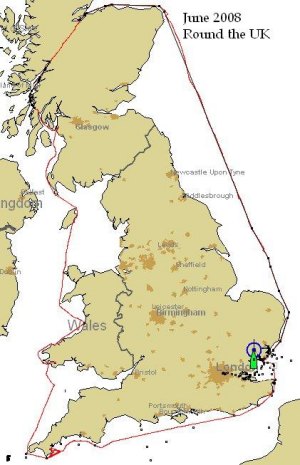 Actual Track |
He asked Rex Davenport and myself to crew the first leg, Rex being an experienced sailor. Both Rex and Alan had work obligations to attend to. Rex needed to get back to work by 2nd June. Alan could do most of his work from the boat (which he often did), but also needed to get back to meet a customer. So we agreed that we would aim to get to Largs marina on the Clyde estuary in order to catch a train back to the homeland on 31st May, leaving the boat moored in the marina for a week or so. Work commitments also fixed our cast off date to 22nd May on the 01:00 tide. This was a pretty tight schedule, and we weighed up the relative merits of sailing around the top end of Scotland, or sailing down the Caledonian Canal. Our thoughts were that the canal would be quicker, and since time was of the essence, this was favourite. As it turned out, we had not anticipated that the locks within the canal system only operated during working hours, forcing us to spend a night half way along the Great Glen. Another deciding factor was the knowledge that along the top end of Scotland there were no places to shelter in, and if a storm cropped up it would have to be ridden out. Thus, we opted for the canal route.
Long Haul to the Moray Firth
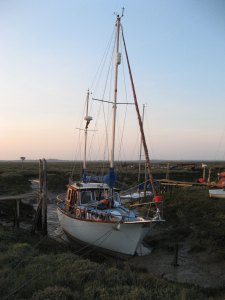 Kiitaja at her Berth in the Saltings on the Eve of Cast Off |
On a bright, sunny morning, after the long leg up the east coast, we observed the gas pipeline survey vessels at work off Peterborough, before veering west into the Moray Firth . With land visible to break up the monotonous seascape, the voyage could only get better. Don't get me wrong, seascapes can be beautiful at times, but three and a half days of choppy, grey North Sea can wear a bit thin.
It was apparent we wouldn't reach Inverness by nightfall, so we put into Lossiemouth. Terra firma felt good again, and after a welcome shower, we celebrated with a couple of beers in the local pub that evening. The following day, we had a few hours to kill until there was sufficient water over the harbour sill, so we made a few repairs to the captain's chair, then Rex and I had a delightful exploration of the town for provisions. Lossiemouth is a small, quiet out of the way town, but we were informed it was only quiet because of the Bank Holiday; normally there would be air force jets screaming overhead. Being in Scotland, I thought a haggis would be a "must buy". Rex happily agreed and we found a good butcher who could oblige.
 Snow-capped Mountains at the End of Cromarty Firth |
 Fort George Guarding the Entrance to the Great Glen |
Once we had a good depth of water, we paid our fees to the cheery Harbour Master, slipped out of Lossiemouth and set course for Inverness. On the way we caught sight of the Cromarty Firth with snow-capped mountains in the distance and now I felt we were in Scotland properly. This was an excellent leg with much whale spotting, marred only by having to take the floor up in order to tighten the engine alternator belt; one of Kiitaja's little quirks. As we headed down the Beauly Firth we passed Fort George guarding the entrance to the Great Glen.
The Caledonian Canal
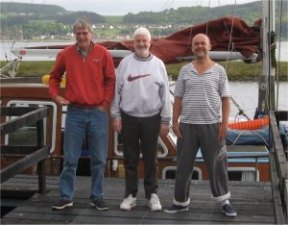 Rex, Alan and me at Clachnaharry |
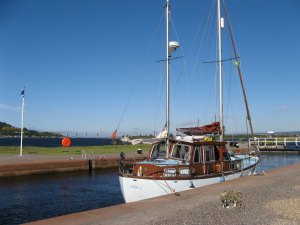 Clachnaharry Sea Lock |
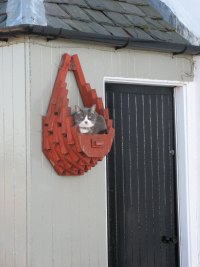 Lock-keeper's Cat |
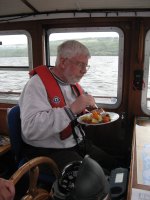 Alan Tucking into Haggis, Neaps and Tatties on Loch Ness |
 22 Miles of Loch Ness Ahead |
Loch Ness is soon reached from Clachnaharry. It and its surroundings can best be described as beautiful, serene, majestic, rugged, romantic and smothered in history. There weren't many vessels about, and we had a glorious journey down its 22 mile length, partially under sail, partially under engine power, to Fort Augustus at its southern end. A highlight of the trip was a lunch of haggis, neaps and tatties; a first for Kiitaja. Rex and I alternated cooking duties, with Alan occasionally turning his hand though he would be the first to admit he is not a natural.
 Looking Down the Flight of Locks at Fort Augustus |
 Beehive Lighthouse at Fort Augustus |
At the entry/exit points of the lochs along the canal small lighthouses can be found, known as beehive lighthouses, as shown in the picture.
 Ben Nevis from Corpach Sea Lock |
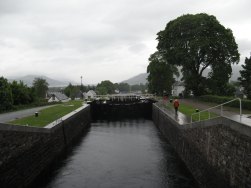 Neptune's Staircase |
When it comes to getting craft through the locks, the procedure is for crew to get out and man-handle the vessels via ropes; one pulling forward, the other slowing the vessel down. This kept me and Rex amused for a while, though I did manage to screw up at one point. Rex had pulled Kiitaja forward, and it was my turn to slow her down. I was rather fierce in my slowing down technique, and completely ripped out a fairlead on the stern, which duly sunk to the bottom of the lock. Alan was quite forgiving, but he must have had a quiet curse too. One of the lock-keepers spotted this, and explained to me the art of slowing boats down without wrecking them. We continued the wee chat and he asked me what the orange contraption on board was. This contraption was a parbuckle, basically a homemade flexible structure that Alan had made for rescuing unconscious folk in the water. The basic idea is to get alongside a body dragging the structure underneath them, then haul the structure and body aboard. There were inherent problems with this regarding rigging fouling the process, and fortunately we have never had to use it in earnest. He expressed in a mixed amused and dour way (if you can imagine that) that this would be futile. By the time such an operation was implemented, the poor soul would almost certainly be devoid of life. He carefully explained to me that he had long been involved in survival techniques, and discussed an exercise where Duncan Goodhew had been immersed in water at 10 deg. C to see how long he could survive before becoming impaired. After 10 minutes Duncan was incapacitated and hallucinating. Now he is a fit fellow, so the great unfit amongst us would only survive for a shorter time. Indeed the lock-keeper pointed out that the Loch water at the time of year we were sailing was only 6 deg. C. There is a moral there.
Loch Oich and then Loch Lochy slipped by, the gloomy mists shrouding the historic bloodbaths draped on these shores. We enjoyed a meal of Scottish Loch trout passing down these lochs, which is rather ironic since I had bought the Scottish trout down in Suffolk! Gliding along these lochs gave me and Rex time to have union meetings. Rex is an endless source of humorous banter; I always enjoy his company, and he has a sympathetic ear to boot. Approaching the south western end of the canal are the magnificent Neptune's Staircase locks. We were the only vessel passing through, and we got down those locks in record time; perhaps the lock-keeper was anxious to get out of the drizzle. To the south of us stood Ben Nevis capped in cloud. A short distance further on, near Fort William, is the Corpach sea lock.
On to Largs via the Crinan Canal
Once released from the restrictions of the locks, we headed down Loch Linnhe through the Corran Narrows leaving the mists of the glens behind. Night descended and Alan took the night watch. He woke Rex and I up in the middle of the night just outside Crinan sea lock. The lock wouldn't open until 08:30 so we hunted around for a buoy to tie up to and went back to our bunks. He mentioned that on the way down he had encountered fiendish currents between the islands.
 Jura Across the Sound from Crinan |
 Dunardry Lock Flight |
The Crinan Canal starts at Crinan on the Sound of Jura, and ends nine miles away at Lochgilphead on Loch Fyne. It was designed to provide a quick link between the west coast and islands at one end and the Clyde Estuary at the other, and so avoid the long voyage around the south end of the Kintyre Peninsula. There are 15 locks and the canal reaches a height of 65 feet above sea level. The summit reach of the canal is less than a mile long, with locks at Dunardry marking the end of the reach. Every time a boat goes through the locks about 300,000 litres of water are used.
The sea lock-keeper at Crinan was also a young woman, this one hailing from near Preston. I pondered for a while on what a laid back enjoyable job that would be, and if I were ever to return to the world of work, this would be ideal, though I should imagine there is a long waiting list and the job is lowly paid. The canal itself is in an idyllic part of Argyll and Bute, with gentle, tranquil, breathtaking and lush landscape as opposed to the rugged surroundings of the Caledonian Canal. A beautiful sunny day made this canal voyage even more exhilarating. One aspect of negotiating the canal that appealed to me was that the locks had to be operated manually by ships' crews; I found this a most enjoyable exercise. It was made easier for us by having another boat pass through at the same time as us, thereby one crew could be opening the next lock gate whilst the other would be closing one behind, effectively doubling our speed through the locks. This was fairly important since the sea lock at Lochgilphead would be closing at the end of the working day.
 Arran |
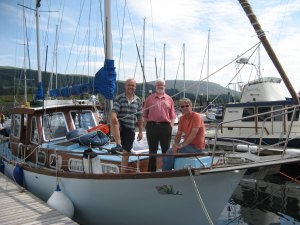 Winding Down in Largs Marina |
Largs, a small resort, has a huge marina capable of holding 600 boats. It is ideally suited as a base for exploring many of the Western Isles. Indeed we met a crew who hail from Lancashire and keep their boat moored there to take advantage of the good sailing to be had amongst these isles, and I'm certain many more do too. There again there are folks from Yorkshire and Kent who keep their craft down at Tollesbury saltings.
I tried to recall a past memory of Largs. When I was at primary school, our school, together with umpteen others in West Cumbria, organised a school trip via steam train to Largs. There we all boarded a steamer which took us up the Clyde to Glasgow. At that time it was an impressive sight and sound, with the banks of the Clyde bustling with activity at the many shipyards. Alas, a bygone era.
On our final night at Largs, we retired to the marina bar where Rex and I sampled what the bar tender offered as a fine malt whisky. It was exquisitely delicious; liquid smoke. Its name, Ardbeg. Try it! The following day we travelled by train to our respective homes, reminiscing on a thoroughly enjoyable voyage.
Down the Welsh Coast
As mentioned earlier it was Alan's intention to solo sail after Largs. He took in the Isle of Man and then sailed on to Aberystwyth to meet up with an old friend of his. Sad to say, it was whilst he was there that he received a call from one of his major clients. Although he could handle most of the software issues remotely, the scope of the new problem necessitated him needing to work alongside the customer over an appreciable amount of time. He was therefore faced with the prospect of leaving Kiitaja moored in Aberystwyth marina, or urgently getting it back to Tollesbury. This would involve continuous sailing, and he needed crew to aid him. Since I wasn't tied to work commitments, he called me to see if I was available. I replied in the affirmative and the following morning I made my way across country; a tortuous route via Norwich since signaling cable thieves had disrupted the trains travelling due west of Ipswich.
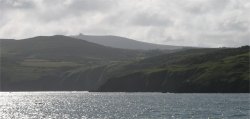 Pembrokeshire Coast from the Relative Calm of Fishguard Bay on a Bright Morning |
Pressing time constraints urged us to venture out the following bright morning. The seas weren't any better, and after a rough crossing over St Brides Bay, we sought a bolt hole at Neyland on the eastern end of Milford Haven. The whiff of oil fumes by the refineries suggested that one spark could send the whole lot up in smoke.
 Milford Haven |
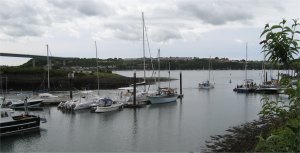 Neyland Marina - Kiitaja on the Right of the Jetty |
Around Land's End
 Porpoise in the Bristol Channel |
 Longships Lighthouse off Land's End |
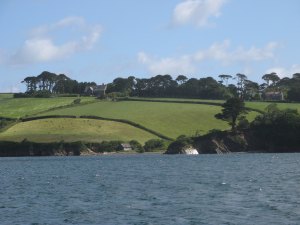 Anchorage in the Helford River |
The weather forecast for the following day was more grey foulness, but we awoke to a surprisingly bright morning in a gorgeous location on the river, and enjoyed a hearty breakfast in these hospitable surroundings. Compared to the incessant lurching al the way down from Milford Haven, this was heaven. We suspected that the relative calm of the river would transform into more troubled waters once we reached the sea, and pondered about whether we should risk it. However, time was pressing on, and it seemed such a lovely day, so we took our chances. We found the open sea fairly choppy but manageable, and decided to head homewards sailing round the clock, weather permitting. |
Whilst we were crossing Lyme Bay with the wind directly behind us, Alan decided to put both the genoa and cruising chute sails up front; a spinnaker would have been a bit of a handful. With the strength of the wind and both these sails inflated, we were sailing along at a fair lick averaging about 11 knots, which is fairly quick for Kiitaja. However, with choppy seas hitting us from the stern, the back end of the boat was being kicked about enough to cause one of the sails to collapse every so often. It was how I imagine riding a bucking bronco to be. Alan was having a hard time trying to keep course so that the sails were both inflated, but he was really enjoying it; perhaps he has masochistic tendencies.
 Genoa and Cruising Chute out for Turbospeed |
 Isle of Wight |
 Beachy Head |
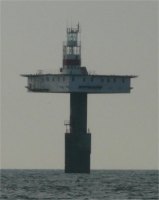 Royal Sovereign Lighthouse |
 Pass Between the Red and Green Buoys Please! |
The journey, although pressurised due to time constraints, was the most challenging, enjoyable and rewarding sails I have had. The combination of long stints way out at sea, together with the canal sections and associated delightful countryside, not forgetting some charming ports of call, made for a trip of unparalleled variety. This was enhanced by the good company of Alan and Rex; two experienced sailors who I had complete confidence in, were good fun and always a pleasure to sail with. A truly memorable adventure!
